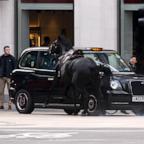Ted Bundy's DNA Could Help Solve Cold Cases
The serial killer's DNA will be added to a national database.
August 5, 2011 -- Twenty-two years ago notorious serial killer Ted Bundy took his last breath in a Florida electric chair. Now his DNA may play a pivotal role in cracking some unsolved murders.
Bundy's full DNA profile will be uploaded to the national CODIS (Combined DNA Index system) database today, where it will exist along with the DNA profiles of 10 million other convicted offenders.
"We have been trying to get a complete profile since early 2000 but we have never been successful until now," said David Coffman, Chief of Forensic Services for the Tallahassee Regional Crime Lab.
Bundy committed at least 30 murders, but he was always coy about how many women he actually killed and is suspected in dozens, even hundreds more murders. That's why cold case investigators across the country have been so anxious to be able to match their evidence against Bundy's DNA.
Tacoma, Wash., Det. Gene Miller and his partner, homicide Det. Lindsey Wade, have waited for this moment for years with a particular case in mind -- the mysterious 1961 disappearance of an 8-year-old girl.
Ann Marie Burr was about to head off to her first day of third grade when she vanished from her Tacoma home.
"Her mother got up at 5:30 in the morning and noticed the front door was opened, and she realized Ann Marie was gone," said Miller. More than 500 people joined the search. "They looked in every yard and every garbage can in every direction… but nothing was ever found," Miller said.
Still, Miller and Wade have "biological material" left over from the crime scene that they hope to compare to Bundy's DNA.
Bundy lived in the north end of Tacoma at the time of her disappearance and had previously lived in the Burr family's neighborhood. Although he was just 15 years old at the time, he has long been a suspect in Ann Marie's disappearance. It would have been one of his first murders.
For his part, Bundy always denied being responsible for the girl's disappearance, even going so far as to put his denials in writing to Ann Marie's mother, Beverly. But Miller said the resolution to any successful cold case requires following every lead -- no matter how unlikely.
"I look at this as an extremely big step and our hope is that it will provide some resolution to the case," he said.
Miller's inquiries initially got things rolling down at David Coffman's lab in Florida.
"When we got a phone call from Washington State we started brainstorming -- who could we call? Who haven't we spoken to?" said Coffman.
The lab been using a partial DNA profile of Bundy's for years, but that proved more frustrating than anything else. They were never able to match Bundy with any unresolved case and it generally raised more questions than answers.
But then Coffman discovered a long-lost vial of Bundy's blood stashed away in a Florida lab.
"The original blood sample was drawn on March 17, 1978 at 1650 hours," said Coffman.
But for the blood to yield a DNA profile it has to be in good condition. "We were skeptical…that's an awful long time for liquid blood to be around," he said.
It turned out the blood sample was bad, but it didn't matter because a few tiny flakes of blood near the top of the tube were in perfect condition, and analysts were able to get a full DNA profile. Bingo. The profile that Coffman had been searching for all these years was finally a reality.




